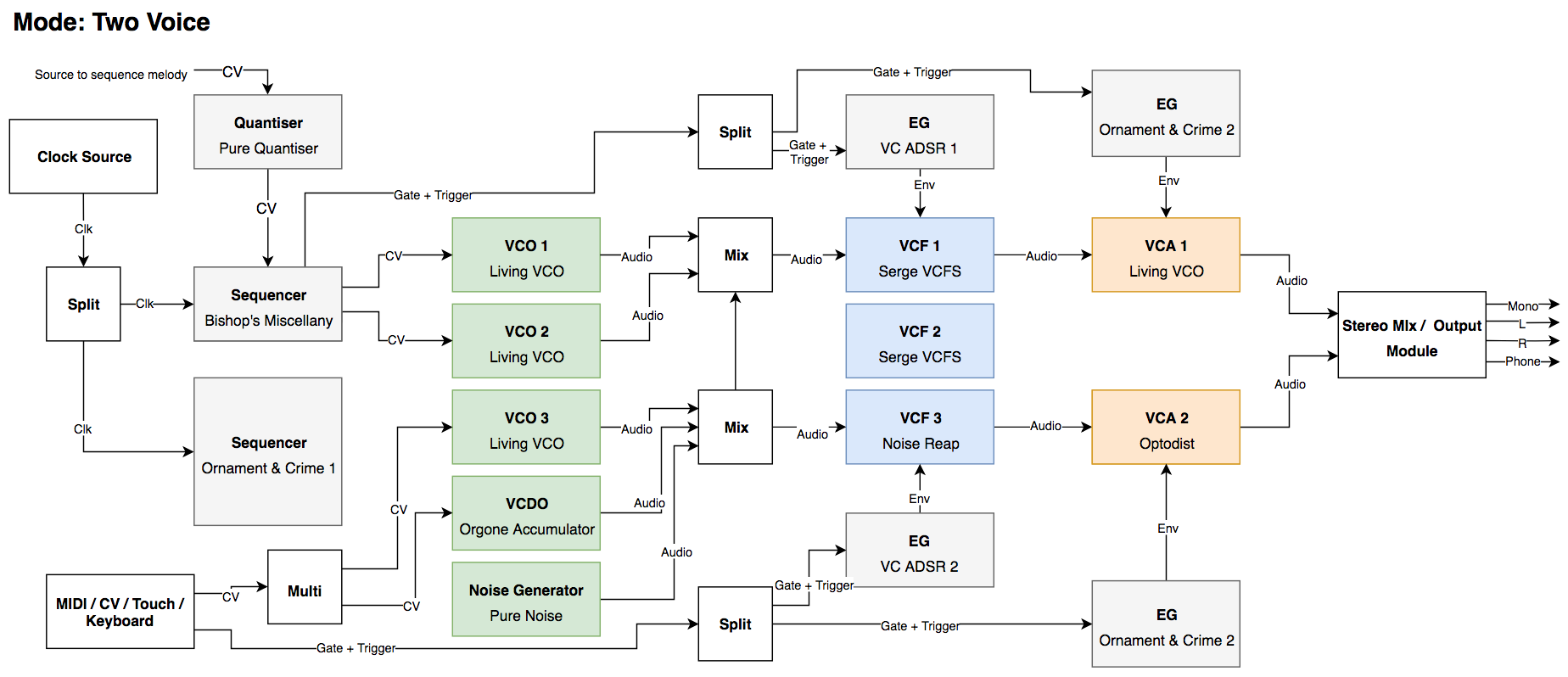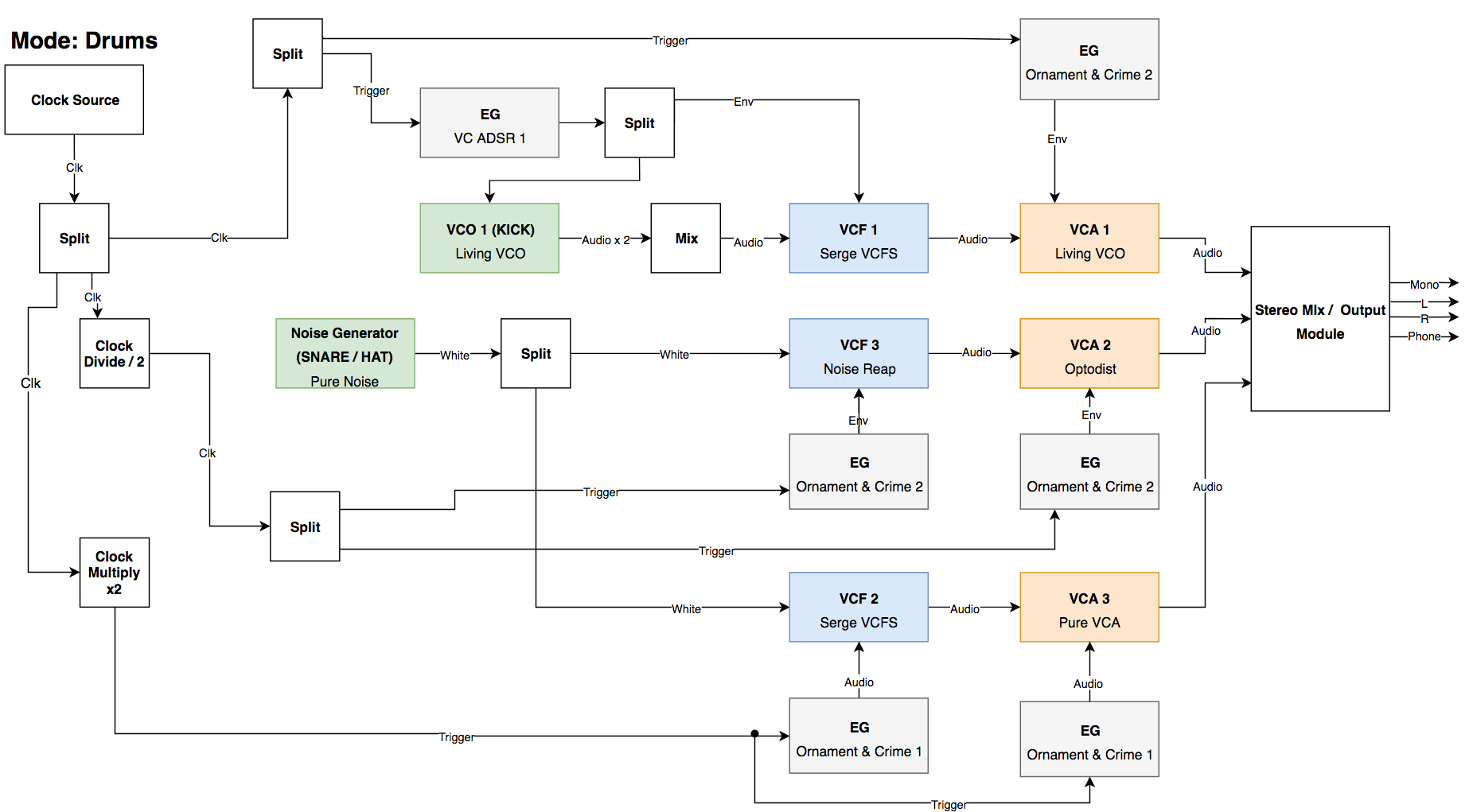In my previous post, I looked at sequencers for my custom modular synthesizer, to compliment the basic synthesizer building blocks of VCO, VCF, VCA, EG etc. But what about all the bits needed to make it all come together? In order to help me, I decided to draw out two minimum scenarios I’d like to achieve with the synthesizer.
Scenario: Two Voice
The Two Voice scenario is based on having two independent voices. These could either be run from the sequencers or a keyboard / CV source, which would need the same clock source. Apart from some mixers, an active multiple for CV and some manual splitting of gate and triggers, this is easily achievable using the modules I’ve selected. At the output stage is a stereo mixer, allowing each voice to be panned as desired. This approach is similar to the much admired Oberheim Two Voice Pro.

I could modify the above diagram by sending the same keyboard CV to both sources in order to have a proper two voice synth. The same VCO/VCF/VCA combos could be used to make the voices identical.
Scenario: Drums
The Drums scenario is based on having a drum pattern triggering a kick, snare, and hi-hat. I want to have enough core modules to run a basic pattern using a clock with multipliers and dividers.

The kick amp and filter envelopes will be triggered via the main clock source, and will share an envelope with the pitch to give that quick high to low swing. The kick sounds is made up of 2 waveform outputs to give a bit of thickness to the sound.
The snare is triggered through a clock divider to create a basic pattern with the snare on each second beat. Synthesising snares can be tricky. Typically you start with white noise, then pass it through one or more filters. With an Oberheim SEM, you can achieve a decent sound using the hi-pass filter, then full resonance at cutoff to pack some punch. It does leave quite a lot of top end, so a second low-pass filter is desirable. But it comes down to which filter and resonance sound is better. In my scenario, using an Optodist amp may be able to colour the sound a nicely, in lieu of a spare filter.
Achieving a hi-hat is simpler. It’s similar to a snare, and can be achieved using a high-pass filter with a higher cut-off and resonance set to taste. A clock multiplier can be used to get the hats on the 16th beats.
To achieve more complicated patterns, I’d need to work our ways to vary the triggers, either via different combinations of clock multipliers / dividers, or by getting more creative using logic modules, attenuators etc. Otherwise (and more simply), I could introduce my dedicated sequencers.
The modules needed
Note that the purpose of this project is to gain experience selecting synth functions. building some PCBs, a case, designing the panel etc, and then to be a basic sketchpad synth and combined with other modular synths I have.
Regarding passive splitters vs active multiples, where perfect pitch retention isn’t needed (e.g. for triggers), the active multis can be replaced by passive multis or split cables. So I’ll probably skip these and add in a set of active multis as needed.
So the minimum set of modules is as follows:
- 1 x Clock source
- 1 x Clock multiplier
- 1 x Clock divider
- 1 x Active 2 output multi
- 1 x 2 input mixer
- 1 x 3 input mixer
- 1 x Stereo mixer output module
But what else should I add? There’s a range of others like attenuverters, logic gates, comparators etc that I can add. I’ll hit up some Facebook groups for recommendations.
In some instances, like in the case of the mixer, I’ll design the circuits, PCB layouts, and get PCBs made myself. This will give me some good practice for designing more complex modules later.

